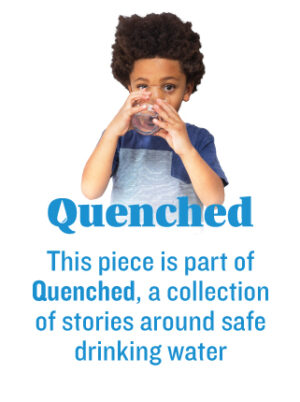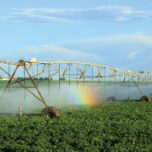March 18, 2013 —  In tiny Seville, Calif., the snow-capped Sierra Nevada mountains rise like a mural behind neat rows of dark-leafed trees studded with bright oranges. The trees rustle as hidden farmworkers pick the ripe fruit. Farming in the fertile Central Valley is worth $17 billion annually and yields nearly half the nation’s fruits, nuts and vegetables. But there’s a high price: Thanks to modern agriculture, the farmworkers who live here can’t drink their own tap water. While pollutants vary, one of the most troublesome is nitrate, a component of nitrogen fertilizer used on these crops that makes the water unfit for human consumption.
In tiny Seville, Calif., the snow-capped Sierra Nevada mountains rise like a mural behind neat rows of dark-leafed trees studded with bright oranges. The trees rustle as hidden farmworkers pick the ripe fruit. Farming in the fertile Central Valley is worth $17 billion annually and yields nearly half the nation’s fruits, nuts and vegetables. But there’s a high price: Thanks to modern agriculture, the farmworkers who live here can’t drink their own tap water. While pollutants vary, one of the most troublesome is nitrate, a component of nitrogen fertilizer used on these crops that makes the water unfit for human consumption.
That this and hundreds of other communities do not have access to safe drinking water — in one of the richest countries in the world — shocked the U.N. special rapporteur on the human right to safe drinking water and sanitation, Catarina de Albuquerque, when she visited Seville and other San Joaquin Valley communities in 2011.
“Nitrate in groundwater is the most significant water quality problem in the nation” —California State Water Resources Control Board
Nitrates in groundwater have become a big problem in many rural communities across the U.S. because, thanks to a powerful agricultural lobby, the federal Clean Water Act exempts virtually all agricultural runoff from regulation. Also, nitrates are increasing in groundwater at the same time that our dependence on groundwater is growing, which could lead to higher costs to treat municipal drinking water.
“Nitrate in groundwater is the most significant water quality problem in the nation, and … commercial fertilizer is the primary source of loading,” concluded a 2011 report from the California State Water Resources Control Board, citing a large body of data. But California is now doing something about that. Last fall, Gov. Jerry Brown made it state policy that every Californian has a right to safe, clean, affordable, accessible drinking water.
“That policy makes a public commitment and also directs state agencies to recognize this issue,” says Maria Herrera, community outreach director for Community Water Center, an advocacy organization headquartered not far from Seville.
In late February 2013, the State Water Resources Control Board submitted a report to the California legislature outlining contaminants in groundwater, affected communities and suggestions to address the problem. To fund the delivery of safe drinking water, the report suggested potential taxes or fees on agricultural commodities, nitrogen fertilizer or water use.
Serious Impacts
This problem isn’t California’s alone. Though the percentage of people nationwide who have no alternative but to drink untreated water contaminated by nitrates is small, typically they are economically disadvantaged people, making this a national environmental justice issue.
Since the 1950s, the increasing industrialization of agriculture has spawned heavy use of commercial fertilizers across the United States. Because crops can’t absorb all the nitrogen fertilizer applied, some nitrates remain. When the crops are irrigated, the nitrates are often transported to surface waters or groundwater. Other sources of nitrate pollution, such as animal waste from dairy and meat production, ineffective sewage treatment plants, and septic system seepage, can exacerbate the problem.
Nitrate pollution is prevalent wherever farming and animal husbandry are intensive. Farming along the Mississippi River watershed conveys nitrates to the Gulf of Mexico, where each summer they stimulate the growth of algae that suck oxygen from the water, killing aquatic life in the aptly named Dead Zone. Chesapeake Bay algae blooms and fish kills are also caused by nutrient pollution, including nitrates. These ecosystems teeter on the brink of collapse, and seafood industries have been decimated by the pollution. Nitrate concentrations in groundwater in several Texas counties have also increased since the 1960s, according to a recent study in the Journal of Environmental Quality.
But as important as they are, environmental impacts are just part of the story. Nitrates have serious implications for human health as well. A 2010 study from the National Cancer Institute found increased risk of thyroid cancer in women associated with higher nitrate levels in public water supplies. Other studies show correlations with spleen and kidney disease and gastrointestinal problems. Perhaps the most evocative concern is blue baby syndrome, or methemoglobinemia, a condition in which infants’ blood can’t deliver enough oxygen to their tissues, causing sickness and death.
The U.S. Environmental Protection Agency has been concerned about nitrates in drinking water since 1977, when it set an interim maximum contaminant level for drinking water of 10 milligrams per liter, the documented threshold to prevent blue baby syndrome. The EPA made this level official in 1991. However, these standards only prompted water cleanup at municipal drinking water facilities. They did nothing to prevent the pollution in the first place.
Rural residents often rely on groundwater that doesn’t go through a municipal drinking water facility, and therefore are disproportionately affected by nitrates. The 2013 California Water Board study identified about 4.1 million people in the state who rely solely on a contaminated groundwater source. Nearly all of that is treated for nitrates and other health hazards prior to distribution. But 2 million more Californians rely on groundwater from private wells or other water-supply systems not regulated by the state. People in Seville all rely on a single contaminated well. And because the average household income is just $14,000 a year, many families can’t afford to buy clean water.
Forty percent of the wells indicated evidence of human-caused nitrate pollution.
A study of groundwater used for public water supplies in San Joaquin Valley found nitrates above the legal limit in 2 percent to 7 percent of the aquifer systems and at moderate concentrations, above half the legal limit, in 9 percent to 20 percent. Statewide, the U.S. Geological Survey detected high concentrations of nitrates in groundwater typically used for public water supply in about 10 percent of aquifers.
Most public-supply aquifers range from about 200 to 800 feet deep, says Jennifer Shelton, a USGS hydrologist who is working on the research. Shelton noted that study reports so far do not include private domestic wells, such as the one used by Seville, which are generally shallower. Shallower groundwater tends to have higher concentrations of nitrates than deeper water, she says.
Nationwide, some 46 million people get their water from private wells. In the early 1990s, the USGS National Water-Quality Assessment Program sampled domestic wells in 48 states. It found that concentrations of nitrate were greater than the legal limit in about 4 percent of the wells. Forty percent of the wells indicated evidence of human-caused nitrate pollution. Those figures may be higher today, as several other studies show that nitrate pollution is increasing in groundwater.
Leading the Way
In the absence of federal action, states can regulate agricultural pollution. Some states are encouraging voluntary measures, such as adopting precision agriculture, to reduce the amount of nutrients that end up in the water. California, however, is leading the way.
The state is divided into nine regional water quality control boards that are semi-autonomous from the State Water Board. Beginning in 2002, seven of the nine began to regulate the effects of irrigation runoff to surface water. They required growers to monitor water quality and to clean up pollution.
The recent flurry of activity surrounding groundwater pollution was initiated with a 2008 state senate bill that prompted the State Water Board’s just-released study on groundwater. But ahead of that, some of the regional water boards began to regulate growers who discharge water from irrigated lands into groundwater and surface water.
Joe Karkoski is program manager for the Central Valley Regional Water Quality Control Board’s irrigated lands program. The Central Valley began to regulate growers’ discharges into groundwater and surface water last year.
Groundwater regulation is particularly difficult because legacy pollution mixes with new. When testing groundwater for contamination, “what you’re observing in the sample could have occurred last week, last month or 50 years ago,” says Karkoski. So instead of trying to link specific groundwater pollution to specific growers, the Central Valley Water Board is trying to ensure that today’s farmers don’t pollute.
The board is beginning to require growers to evaluate their management practices to ensure they are protecting groundwater and surface water. In areas impacted by nitrates, growers will need to develop nitrogen management plans certified by a qualified crop advisor or attend special training to self-certify. The board will inspect self-certifiers, says Karkoski.
Best practices are being determined now through studies that will take several years to complete. Scientists will look at nitrogen use efficiency, defined as a ratio of total nitrogen applied over crop need. They will also examine irrigation efficiency. “Nitrates don’t move on their own. They move with water,” says Karkoski.
But, he hastened to add, “the regional board isn’t going to tell farmers how to farm.” The board will set numbers for the level of water quality that growers must achieve and will assume that growers who use the practices identified by studies are doing the best they can to protect groundwater quality.
“Growers are free to use other techniques, but they’d have to demonstrate to the water board that their practices protect water quality,” says Karkoski.
Water quality monitoring and enforcement will also be key elements of the program.
Federal Action?
On the federal level, the Clean Water Act exemption for agricultural runoff has stood for 40 years and appears in no danger of being revoked — although in recent years EPA has instituted some narrow regulations governing large meat and dairy production operations.
The main federal program aimed at reducing nitrogen loads to surface waters is voluntary. For 27 years, the U.S. Department of Agriculture has run the Conservation Reserve Program, which pays farmers rent to idle or plant cover crops on environmentally sensitive land along water bodies. The goal is to avoid erosion and agricultural pollution to surface waters. However, in recent years, the corn ethanol boom has prompted some farmers to allow the contracts to lapse in favor of planting corn. And studies show that this voluntary program has had little effect on the size of the Dead Zone in the Gulf of Mexico.
For decades the EPA has acknowledged that nutrients are a serious threat to water quality.
In an attempt to prompt federal regulation to control nutrient pollution such as nitrogen and phosphorus in water, the Natural Resource Defense Council, working with a coalition of watershed groups along the Mississippi River, has undertaken a series of lawsuits over the past several years.
“The EPA and states have the obligation to look at what’s polluting their waters and are supposed to set numeric criteria for all of those pollutants to make sure the water remains healthy,” says Ann Alexander, a senior attorney for NRDC. If there were numeric targets for allowable nutrient pollution levels, states would be obligated to ensure that the targets are met and to identify contributing sources.
For decades the EPA has acknowledged that nutrients are a serious threat to water quality. But it has done nothing substantial to address the problem. So in 2008, the NRDC filed a petition asking the EPA to set numbers because states had not. After years of delay, the EPA finally responded, acknowledging again that nutrients are an important problem that needs to be addressed but failing to set numbers.
NRDC’s current lawsuit against the EPA contends that that response is legally deficient. The court will rule sometime after May 2013.
But, even if the NRDC wins, agriculture will still be exempt from getting permits for its runoff discharges under the Clean Water Act. For this reason, NRDC has spent considerable effort trying to get the EPA to enforce Clean Water Act regulations on point-source pollution, such as sewage treatment plants. Although they are a minority contributor to the nitrogen pollution, “You go after the part of the problem you can go after,” says Alexander.
The organization submitted another petition in 2007 to push the EPA to modernize sewage treatment plant requirements. The Clean Water Act requires the EPA to publish information about new technology available for secondary sewage treatment “from time to time.” It hasn’t done so since 1985. “‘Time to time’ is an imprecise term,” says Alexander, “but it’s got to mean something other than never.”
In December 2012, EPA responded the 2007 petition, saying that it would put out new secondary treatment information, but it wouldn’t address how such treatment can remove nutrients.
Cleaning Up
To meet drinking water standards in places where water supplies are polluted with nitrates, municipal drinking water facilities use technologies that have been approved by the EPA for cleaning the water. Reverse osmosis pushes water through a filter to clean it. Ion exchange swaps nitrate ions with benign ions. Electrodialysis uses electricity to push ions through a membrane. These processes filter out nitrates and concentrate them into a waste stream.
A new commercial technology, not yet approved by the EPA, aims to eliminate the waste stream. APTwater, based in Long Beach, Calif., grows autotrophic bacteria on the surface of the filter. The bacteria consume the nitrate, thus decomposing it.
Called the ARoNite system, it’s being tested in Rancho Cucamonga, Calif., a town near the agricultural communities east of Los Angeles. “We’re pumping and treating the water but are not putting it into the municipal system yet because we haven’t gotten the final approval from the California Department of Public Health,” says John Kaestle, the company’s CEO.
A $1 million to $1.5 million system could serve 3,000 to 10,000 people, says David Friese, technology director for ARoNite.
The economics of such a technology can work in a place like California, where water supplies are extremely tight. “Where you have a very high cost of water acquisition, like in Southern California, then treating the water and making it potable makes sense,” says Kaestle.
However, in places like the Mississippi River watershed, there may be lower-cost alternatives to treating nitrate-polluted water, he points out. These include dilution: Water treatment plants often mix in water from uncontaminated sources to get nitrate levels below the local public health threshold.
Signs of Hope
Seville has been fighting for clean water since 2007, and in 2010, its activists were largely ignored, spinning their wheels against bureaucracy. Now there are new signs of hope.
The Human Right to Water Act, the governor’s focus group for disadvantaged communities and the recommendations in the State Water Board report are all directing fresh prioritization and resources toward meeting the needs of people who have long been stuck with polluted water. The focus group dedicated at least $20 million per year to deliver safe water to the 2.5 million people affected in Salinas and Tulare counties.
All the attention should make it easier for small communities to access county and state money, says Herrera. For Seville, it already has. The town has secured funding via Tulare County from the California Department of Public Health to study possible clean water solutions for Seville, select one and conduct a feasibility study, says Herrera. After 18 months, the county can choose an option and obtain additional money for planning and construction.
One possibility is to partner with a neighboring community, Yettem, to consolidate resources, governance and infrastructure. The county has also secured funding for a regional study that will consider how to address the long-term needs of the entire region. Several other tiny communities are located nearby. “Like Seville, they have no clean water,” says Herrera. Another possibility is to partner with the irrigation district to bring in surface water and treat it centrally for all these communities.
“We’ve seen movement and changes,” says Herrera. “It will hopefully keep getting better if the communities continue to stay engaged and hold decision makers accountable.”
Herrera is pleased that things are moving. “But we’re still looking at another three years before the community sees a permanent clean water, best case scenario,” says Herrera.
In the meantime, the people of Seville shouldn’t have to drink tainted water for too much longer. At the governor’s drinking water stakeholder group, Herrera’s organization and other advocates recommended that the state allow emergency funds from the Department of Public Health to be used for interim projects. That policy took effect in January 2013.
Tulare Country is currently seeking these funds to set up an interim solution to get Seville residents clean water until a longer term solution can be enacted. For example, the county might purchase and install a water dispensing machine at the local elementary school for both students and residents. The machine would use reverse osmosis to filter contaminants from Seville’s well and allow residents to take home clean water in five-gallon jugs.
“We’ve seen movement and changes,” says Herrera. “It will hopefully keep getting better if the communities continue to stay engaged and hold decision makers accountable.”
Ultimately to achieve the goals of the Clean Water Act and Safe Drinking Water Act, the U.S. will have to regulate agricultural pollution. If California succeeds, perhaps the country will follow.
Related Posts
Ensia shares solutions-focused stories free of charge through our online magazine and partner media. That means audiences around the world have ready access to stories that can — and do — help them shape a better future. If you value our work, please show your support today.
Yes, I'll support Ensia!



